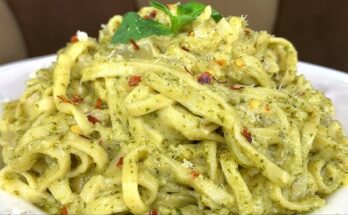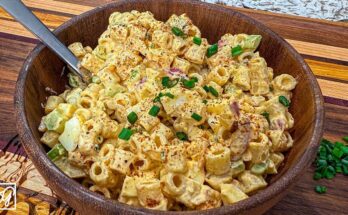Snow Peas Recipe: Snow peas are one of those underrated yet super versatile vegetables that don’t just bring color and crunch to your meals—they’re also loaded with nutrients.
In this guide, we’re diving into a flavorful and foolproof snow peas recipe that’s simple enough for beginners but satisfying enough to keep you coming back for more.
Whether you’re sautéing them in garlic butter or tossing them into a vibrant stir-fry, this guide will make sure your snow peas shine every time.
What Are Snow Peas?
Snow peas are flat, crisp legumes with tiny, underdeveloped peas inside. Unlike garden peas, the entire pod of the snow pea is edible, which makes them perfect for quick cooking and crunchy snacking. Native to the Mediterranean region and widely used in Asian cuisine, snow peas are known for their mild sweetness and tender bite. Their vibrant green color and quick-cooking nature make them a staple in stir-fries, salads, and light side dishes.
These little green gems are incredibly versatile. Whether you’re sautéing them with garlic, steaming them lightly, or using them raw in a salad, snow peas bring a pop of freshness and crunch to the plate. And here’s the best part—they cook in minutes, making them the ultimate veggie for weeknight dinners.
Health Benefits of Snow Peas
Aside from being a flavor booster, snow peas are a nutritional powerhouse. They’re low in calories yet rich in vitamins like Vitamin C, Vitamin K, and folate. They’re also a good source of dietary fiber and antioxidants, which support digestion and fight off oxidative stress.
Here are a few top health benefits:
- High in Fiber: Great for gut health and keeping you full.
- Low in Calories: Perfect for those watching their weight.
- Rich in Vitamins and Minerals: Boost your immunity and overall health.
- Contains Antioxidants: Helps reduce inflammation and fight free radicals.
Incorporating snow peas into your meals is not just delicious but a step toward better health.
Ingredients Needed
Fresh and Flavorful Essentials
For a classic and simple snow peas stir-fry, here are the must-have ingredients:
- 2 cups fresh snow peas
- 1 tablespoon olive oil or sesame oil
- 2 cloves garlic, minced
- Salt and pepper to taste
- 1 tablespoon soy sauce
These ingredients form the base of the recipe. The snow peas deliver the crunch, garlic brings the aroma and depth, while soy sauce ties everything together with its savory punch.
Optional Add-ons for Variation
Want to spice things up or add a personal twist? Here are a few extras you can toss in:
- Chili flakes for some heat
- Ginger slices for a zingy aroma
- Sesame seeds for a nutty crunch
- Toasted almonds or cashews for texture
- A splash of lemon juice for brightness
- Mushrooms, bell peppers, or carrots to bulk up the dish
This flexibility is what makes snow peas such a dream to cook with. Whether you’re keeping it simple or going full gourmet, you can make it your own.
Preparing Snow Peas
Cleaning and Trimming Tips
Before you jump into cooking, there’s a bit of prep work involved with snow peas. It’s simple but important for both texture and appearance.
- Wash thoroughly under cool running water to remove dirt and pesticide residues.
- Trim the ends with a sharp knife or kitchen scissors.
- Remove the string along the seam of the pod (if it’s visible). This fibrous string can be tough and chewy when cooked.
Pro tip: If your snow peas are very young and tender, you might get away without stringing them. But for most supermarket varieties, taking that extra minute makes a huge difference in mouthfeel.
Blanching vs. Stir-Frying – What’s Better?
There are a couple of ways to cook snow peas, and both have their own appeal:
- Blanching: This involves boiling the peas briefly (1-2 minutes), then plunging them into ice water. It keeps them crisp-tender and vibrant green—perfect for salads.
- Stir-Frying: This is the go-to method in Asian dishes. Quick and high-heat cooking with oil and aromatics like garlic gives them that delicious, slightly smoky flavor.
For this recipe, we’ll go the stir-fry route—it’s fast, flavorful, and retains that signature crunch we all love.
Step-by-Step Recipe Guide
Step 1: Gather Ingredients
Let’s kick off with the basics. Before diving into the cooking process, make sure you’ve got everything you need on the counter. This helps you move quickly through each step and ensures nothing’s forgotten in the heat of the moment.
Here’s your quick ingredient checklist:
- 2 cups fresh snow peas
- 1 tablespoon sesame oil (or olive oil)
- 2 cloves of garlic, minced
- 1 tablespoon soy sauce (low sodium preferred)
- A pinch of salt
- Freshly ground black pepper
- Optional: chili flakes, sesame seeds, ginger, or lemon juice
Take a few extra minutes to slice and prep any add-ons like mushrooms, carrots, or bell peppers if you’re aiming for a more elaborate dish. Once everything is ready to go, cooking becomes almost effortless.
This prep stage is like setting up your canvas before painting. With your ingredients organized and prepped, you’ll enjoy a smoother and more enjoyable cooking experience.
Step 2: Prep the Snow Peas
Now let’s turn our attention to the stars of the dish—the snow peas.
Follow these steps:
- Wash the peas: Rinse them thoroughly under cold water to remove any debris or chemicals.
- Trim the tips: Use a knife or scissors to cut off both ends.
- Remove the string: This string runs along the edge of the pod. Grab one end and gently pull it down to remove it. This step ensures a tender bite without any fibrous surprises.
If you’re short on time, some grocery stores sell pre-trimmed snow peas, but doing it yourself usually guarantees fresher, crunchier results.
Bonus Tip: If you want extra snap and color, you can soak the trimmed peas in ice water for a few minutes before cooking. It refreshes them and helps retain that signature bright green look.
Step 3: Cook to Perfection
Time to bring the heat! Cooking snow peas is quick and easy, but the timing is crucial to maintain their crunch.
Here’s how to do it:
- Heat a skillet or wok over medium-high heat.
- Add sesame oil and swirl to coat the pan.
- Toss in minced garlic and let it sizzle for 15–20 seconds—just enough to infuse the oil.
- Add the snow peas and stir-fry for 2–3 minutes. Keep them moving so they cook evenly but don’t burn.
- Add soy sauce, a pinch of salt, and black pepper. Stir for another minute until everything’s well coated.
You want the peas to remain crisp and vibrant, not limp and soggy. If they start to brown too much, reduce the heat slightly.
Optional Add-ons (if using):
- Add chili flakes or ginger halfway through for a bolder flavor.
- Toss in sliced mushrooms or bell peppers at the start to cook alongside the peas.
- Sprinkle sesame seeds just before serving for a nice crunch.
Step 4: Season and Serve
Now that the peas are tender-crisp and coated in that garlicky-soy glaze, it’s time to finish up and serve.
Finishing touches:
- Squeeze a bit of lemon juice on top for brightness.
- Sprinkle with toasted sesame seeds or chopped almonds for extra texture.
- Add fresh herbs like cilantro or green onions if you like a herbal finish.
How to serve:
- As a side dish to grilled meats or tofu.
- Toss into noodles or rice bowls.
- Pair with teriyaki chicken or baked salmon for a full meal.
- Serve cold over salads for a crunchy twist.
These snow peas aren’t just a side—they’re a star in their own right. With that perfect blend of savory, garlicky, and fresh flavors, you’ll be hooked after the first bite.
Tips for Perfect Snow Peas Every Time
Common Mistakes to Avoid
Even though snow peas are super simple to cook, a few missteps can ruin their texture or taste. Here are the most common mistakes and how to avoid them:
- Overcooking: This is the number one mistake. Snow peas only need 2–3 minutes on the heat. Any longer, and they lose their crunch and vibrant color.
- Skipping the string removal: Those fibrous strings can make your peas chewy and unpleasant. Take the extra minute to remove them.
- Not drying them properly: Wet peas will steam instead of stir-fry. After rinsing, pat them dry with a towel before adding them to the hot pan.
- Too much seasoning: Keep the flavors light. Snow peas have a natural sweetness that you don’t want to mask.
Avoiding these pitfalls ensures your snow peas come out restaurant-worthy every time.
Expert Cooking Hacks
Want to take your snow peas to the next level? Try these expert-approved tips:
- Use a carbon steel wok for the best heat distribution and classic stir-fry flavor.
- Flash blanch before stir-frying for extra crispness—boil for 30 seconds, then transfer to ice water, dry, and stir-fry.
- Double oil trick: Start with a little oil for cooking, then drizzle a tiny bit of flavored oil (like chili or sesame) after cooking for extra aroma.
- Add a pinch of sugar to enhance their natural sweetness—especially if your soy sauce is salty.
- Use aromatics like scallions or ginger to layer flavors.
These hacks don’t take much effort but can make your snow pea dish stand out.
FAQs about Snow Peas Recipe
Can I use frozen snow peas?
Yes, you can! While fresh snow peas offer the best texture and flavor, frozen ones are a good alternative, especially if you’re in a pinch. Just make sure to thaw them fully and pat them dry before cooking to avoid excess moisture, which can make them soggy.
How do I store leftovers?
Leftover cooked snow peas can be stored in an airtight container in the fridge for up to 3 days. To reheat, use a skillet over medium heat for a minute or two, or microwave them for 30 seconds. Just note they may lose some of their original crunch after reheating.
Are snow peas good for weight loss?
Absolutely! Snow peas are low in calories and high in fiber, making them a great addition to any weight loss plan. They help keep you full longer and provide essential nutrients without adding a ton of calories.
Can I eat snow peas raw?
Yes, snow peas are delicious raw! They’re sweet, crisp, and make a perfect addition to salads or a healthy snack with hummus or dip. Just be sure to wash them well and remove the tough string along the edge before eating.
What dishes pair well with snow peas?
Snow peas pair well with a wide range of dishes. Try them with:
- Stir-fried noodles or rice
- Teriyaki chicken or salmon
- Tofu or seitan for a plant-based option
- In cold salads or Buddha bowls
- As a topping for ramen or pho
They’re incredibly versatile and can be used in both Asian and Western-style meals.
Conclusion
The beauty of this recipe lies in its simplicity. You don’t need a long list of ingredients or fancy equipment. Just fresh produce, a hot pan, and a few minutes of your time. And the result? A bright, healthy, and crave-worthy dish that can stand on its own or complement virtually any main course.
So next time you’re looking for a veggie that’s fast, fresh, and fabulous—reach for snow peas. With the right prep and a hot pan, they’ll never let you down.



